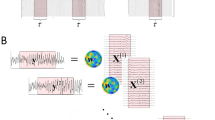Abstract
This paper introduces source coherence, a new method for the analysis of cortical coherence using noninvasive EEG and MEG data. Brain electrical source analysis (BESA) is applied to create a discrete multiple source model. This model is used as a source montage to transform the recorded data from sensor level into brain source space. This provides source waveforms of the modeled brain regions as a direct measure for their activities on a single trial basis. The source waveforms are transformed into time-frequency space using complex demodulation. Magnitude-squared coherence between the brain sources reveals oscillatory coupling between sources. This procedure allows one to separate the time-frequency content of different brain regions even if their activities severely overlap at the surface. Thus, source coherence overcomes problems of localization and interpretation that are inherent to coherence analysis at sensor level. The principle of source coherence is illustrated using an EEG recording of an error-related negativity as an example. In this experiment the subject performed a visuo-motor task. Source coherence analysis revealed dynamical linking between posterior and central areas within the gamma-band around the time of button press at a post-stimulus latency of 200-300 ms.
Similar content being viewed by others
References
Gross, J., Kujala, J., Hämäläinen, M., Timmermann, L., Schnitzler, A. and Salmelin, R. Dynamic imaging of coherent sources: Studying neural interactions in the human brain. Proc. Nat. Acad. Sci., 2001, 98: 646–699.
Knyazeva, M.G. and Innocenti, G.M. EEG coherence studies in the normal brain and after early-onset cortical pathologies. Brain Res., 2001, 36: 119–128.
Luu, P. and Tucker, D.M. Regulating action: alternating activation of midline frontal and motor cortical networks. Clin.Neurophysiol., 2001, 112: 1295–1306.
Nunez, P.L., Srinivasan, R., Westdorp, A.F., Wijesinghe, R.S., Tucker, D.M., Silberstein, R.B. and Cadusch, P.J. EEG coherency I: statistics, reference electrode, volume conduction, Laplacians, cortical imaging, and interpretation at multiple scales. Electroenceph. Clin. Neurophysiol., 1997, 103: 499–515.
Nunez, P.L., Silberstein, R.B., Shi, Z., Carpenter, M.R., Srinivasan, R., Tucker, D.M., Doran, S.M., Cadusch, P.J. and Wijesinghe, R.S. EEG coherency II: experimental comparisons of multiple measures. Electroenceph. Clin. Neurophysiol., 1999, 110: 469–486.
Papp, N. and Ktonas, P. Critical evaluation of complex demodulation techniques for the quantification of bioelectrical activity. Biomed. Sci. Instrum., 1977, 13: 135–143.
Pfurtscheller, G. and Lopes da Silva, F.H. Event-related EEG/MEG synchronization and desynchronization: basic principles. Clin. Neurophysiol., 1999, 110: 1842–1857.
Scherg, M. and Von Cramon, D. Evoked dipole source potentials of the human auditory cortex. Electroenceph. Clin. Neurophysiol., 1986, 65: 344–360.
Scherg, M. Fundamentals of dipole source potential analysis. In: F. Grandori, M. Hoke and G.L. Romani (Eds.), Auditory evoked magnetic fields and electric potentials. Advances in Audiology, Vol. 6. Karger, Basel, 1990: 40–69.
Scherg, M. and Ebersole, J.S. Brain source imaging of focal and multifocal epileptiform EEG activity. Neurophysiol. Clin., 1994, 24: 51–60.
Scherg, M. and Berg, P. New concepts of brain source imaging and localization. Electroencephal. Clin. Neurophysiol. Suppl., 1996, 46: 127–137.
Scherg, M., Ille, N., Bornfleth, H. and Berg, P. Advanced tools for digital EEG review: virtual source montages, whole-head mapping, correlation, phase analysis. J. Clin.Neurophysiol., 2002, 19: 91–112.
Singer, W. and Gray, C.M. Visual feature integration and the temporal correlation hypothesis. Ann. Rev. Neurosci., 1995, 18: 555–586.
Author information
Authors and Affiliations
Rights and permissions
About this article
Cite this article
Hoechstetter, K., Bornfleth, H., Weckesser, D. et al. BESA Source Coherence: A New Method to Study Cortical Oscillatory Coupling. Brain Topogr 16, 233–238 (2004). https://doi.org/10.1023/B:BRAT.0000032857.55223.5d
Issue Date:
DOI: https://doi.org/10.1023/B:BRAT.0000032857.55223.5d




